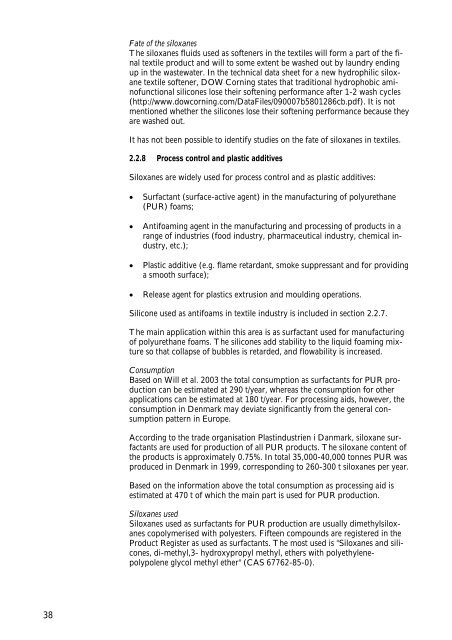No. 1031 - Miljøstyrelsen
No. 1031 - Miljøstyrelsen
No. 1031 - Miljøstyrelsen
Create successful ePaper yourself
Turn your PDF publications into a flip-book with our unique Google optimized e-Paper software.
38<br />
Fate of the siloxanes<br />
The siloxanes fluids used as softeners in the textiles will form a part of the final<br />
textile product and will to some extent be washed out by laundry ending<br />
up in the wastewater. In the technical data sheet for a new hydrophilic siloxane<br />
textile softener, DOW Corning states that traditional hydrophobic aminofunctional<br />
silicones lose their softening performance after 1-2 wash cycles<br />
(http://www.dowcorning.com/DataFiles/090007b5801286cb.pdf). It is not<br />
mentioned whether the silicones lose their softening performance because they<br />
are washed out.<br />
It has not been possible to identify studies on the fate of siloxanes in textiles.<br />
2.2.8 Process control and plastic additives<br />
Siloxanes are widely used for process control and as plastic additives:<br />
• Surfactant (surface-active agent) in the manufacturing of polyurethane<br />
(PUR) foams;<br />
• Antifoaming agent in the manufacturing and processing of products in a<br />
range of industries (food industry, pharmaceutical industry, chemical industry,<br />
etc.);<br />
• Plastic additive (e.g. flame retardant, smoke suppressant and for providing<br />
a smooth surface);<br />
• Release agent for plastics extrusion and moulding operations.<br />
Silicone used as antifoams in textile industry is included in section 2.2.7.<br />
The main application within this area is as surfactant used for manufacturing<br />
of polyurethane foams. The silicones add stability to the liquid foaming mixture<br />
so that collapse of bubbles is retarded, and flowability is increased.<br />
Consumption<br />
Based on Will et al. 2003 the total consumption as surfactants for PUR production<br />
can be estimated at 290 t/year, whereas the consumption for other<br />
applications can be estimated at 180 t/year. For processing aids, however, the<br />
consumption in Denmark may deviate significantly from the general consumption<br />
pattern in Europe.<br />
According to the trade organisation Plastindustrien i Danmark, siloxane surfactants<br />
are used for production of all PUR products. The siloxane content of<br />
the products is approximately 0.75%. In total 35,000-40,000 tonnes PUR was<br />
produced in Denmark in 1999, corresponding to 260-300 t siloxanes per year.<br />
Based on the information above the total consumption as processing aid is<br />
estimated at 470 t of which the main part is used for PUR production.<br />
Siloxanes used<br />
Siloxanes used as surfactants for PUR production are usually dimethylsiloxanes<br />
copolymerised with polyesters. Fifteen compounds are registered in the<br />
Product Register as used as surfactants. The most used is "Siloxanes and silicones,<br />
di-methyl,3- hydroxypropyl methyl, ethers with polyethylenepolypolene<br />
glycol methyl ether" (CAS 67762-85-0).

















